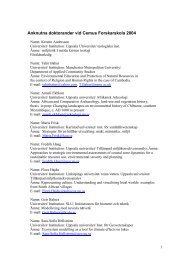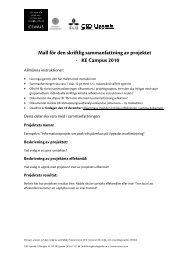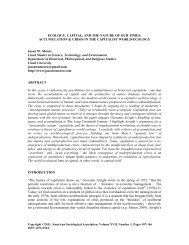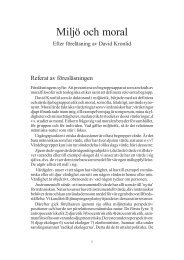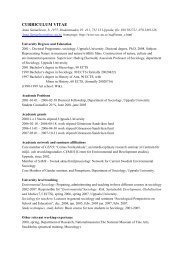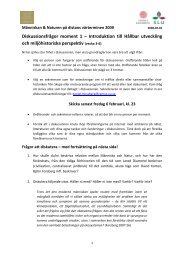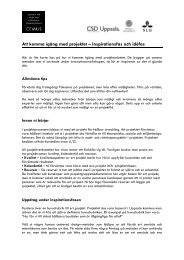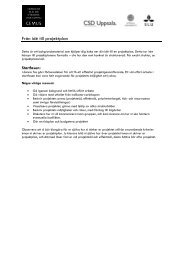Benefits of genetically modified crops for the poor - entsteht die ...
Benefits of genetically modified crops for the poor - entsteht die ...
Benefits of genetically modified crops for the poor - entsteht die ...
You also want an ePaper? Increase the reach of your titles
YUMPU automatically turns print PDFs into web optimized ePapers that Google loves.
REVIEW New Biotechnology Volume 27, Number 5 November 2010ReviewTABLE 2Comparative advantage <strong>of</strong> Bt over conventional cotton in India.2002 2004 2006 AverageInsecticide use 50% 51% 21% 41%Yield +34% +35% +43% +37%Seed cost +221% +208% +68% +166%Total cost +17% +11% +24% +17%Gross revenue +33% +37% +40% +37%Pr<strong>of</strong>it +69% +129% +70% +89%Pr<strong>of</strong>it gain in US$/ha +111$ +142$ +152$ +135$Source: [5].area. Most <strong>of</strong> <strong>the</strong> cotton farms are small-scale, especially in centraland sou<strong>the</strong>rn India. The average size <strong>of</strong> Bt-adopting farms is lessthan 5 ha, with an average cotton area <strong>of</strong> about 1.5 ha. There<strong>for</strong>e, acloser look at <strong>the</strong> impacts in India is particularly interesting.Table 1 shows cotton enterprise budgets in India with andwithout Bt technology <strong>for</strong> three growing seasons between 2002and 2006. The data were collected from randomly sampled farmsin four states and are representative <strong>of</strong> India’s smallholder-dominatedcotton production systems [3]. The results are summarisedin Table 2. In all three seasons, <strong>the</strong> number <strong>of</strong> insecticide spraysand insecticide amounts used were significantly lower on Bt thanon conventional plots. The exact reductions vary from year toyear, which is partly due to seasonal variations in pest pressure.Moreover, owing to increasing adoption <strong>of</strong> Bt over time, target pestpopulations declined, so that even conventional cotton growerscould reduce <strong>the</strong>ir insecticide sprays considerably in recent years.Average reductions in insecticide use through Bt technology were41% over <strong>the</strong> three growing seasons. These reductions occurmostly in highly toxic chemicals, so that Bt cotton is also associatedwith significant benefits <strong>for</strong> <strong>the</strong> environment and farmers’health.In addition to insecticide reductions, a major effect <strong>of</strong> Bt cottonin India is a sizeable yield advantage due to lower crop losses, aspreviously predicted by Qaim and Zilberman [4]. Over <strong>the</strong> years,average yields were 30–40% higher on Bt than on conventionalplots, which is due to more effective pest control and thus areduction in crop damage. Again, differences over <strong>the</strong> years arelargely due to variability in pest pressure. Regression analysesconfirm <strong>the</strong> gains in effective yields through Bt even after controlling<strong>for</strong> differences in input use and o<strong>the</strong>r factors [3,5]. Higheryields and crop revenues are also <strong>the</strong> main reasons <strong>for</strong> <strong>the</strong> significantgains in cotton pr<strong>of</strong>its, in spite <strong>of</strong> higher seed prices. Pr<strong>of</strong>itdifferences between Bt and conventional cotton even increasedover time, which is partly due to seed price caps that state governmentshave introduced since 2006. Over <strong>the</strong> three seasonsobserved, mean pr<strong>of</strong>it gains were in a magnitude <strong>of</strong> 89%, or 135US$ per ha. These are large benefits <strong>for</strong> cotton-producing householdsin India, many <strong>of</strong> whom live near or below <strong>the</strong> poverty line.Extrapolating <strong>the</strong>se pr<strong>of</strong>it gains to <strong>the</strong> total area under Bt cotton inIndia (8.4 million ha) implies an additional 1.13 billion US$ peryear in <strong>the</strong> hands <strong>of</strong> smallholder farmers.In spite <strong>of</strong> this evidence, which is also confirmed in o<strong>the</strong>r stu<strong>die</strong>s[6,7], <strong>the</strong>re are widespread public concerns that smallholder farmerswould not benefit from Bt and that <strong>the</strong> technology wouldra<strong>the</strong>r cause economic and social problems among <strong>the</strong> <strong>poor</strong> [8].What <strong>the</strong> mean values discussed above (Tables 1 and 2) mask isthat <strong>the</strong>re was considerable impact variability in <strong>the</strong> early years <strong>of</strong>Bt cotton adoption. Especially in 2002, <strong>the</strong>re were some farmers incertain regions who did not pr<strong>of</strong>it, due to insufficient in<strong>for</strong>mationon how to use <strong>the</strong> technology successfully. Moreover, only a smallnumber <strong>of</strong> Bt varieties were available, which were not suitable <strong>for</strong>all agroecological conditions [3,9]. These initial problems wereovercome, however, as is reflected in <strong>the</strong> rapid and widespreadaggregate adoption.Income distribution and poverty in IndiaBeyond <strong>the</strong> direct effects on crop pr<strong>of</strong>its <strong>for</strong> adopting farmers, newtechnologies such as Bt cotton also entail indirect effects throughbackward and <strong>for</strong>ward linkages to o<strong>the</strong>r markets. For instance,higher cotton yields through Bt provide more employment opportunities<strong>for</strong> agricultural labourers and a boost to rural transport andtrading businesses. Income gains among farmers and farm workersentail higher demand <strong>for</strong> food and non-food items, inducinggrowth and household income increases also in o<strong>the</strong>r local sectors.Such indirect effects were positive and large <strong>for</strong> Green Revolutiontechnologies in <strong>the</strong> 1970s and 1980s [10]. Related stu<strong>die</strong>s <strong>for</strong> GM<strong>crops</strong> have hardly been carried out. One exception is Bt cotton inIndia, <strong>for</strong> which wider rural development effects have been analyzedby Qaim et al. [11] and Subramanian and Qaim [12]. Theresults <strong>of</strong> this research are summarised in <strong>the</strong> following.Using detailed census data from a typical cotton-growing villagein central India and building on a social accounting matrix (SAM)multiplier model, <strong>the</strong> total income effects <strong>of</strong> Bt cotton wereestimated. These effects not only incorporate <strong>the</strong> direct benefits<strong>for</strong> cotton farmers in terms <strong>of</strong> higher pr<strong>of</strong>its, but also include <strong>the</strong>indirect effects that occur in o<strong>the</strong>r markets and sectors. Overall,each ha <strong>of</strong> Bt cotton creates aggregate incomes that are 246 US$higher than those <strong>of</strong> conventional cotton (Figure 1). For <strong>the</strong> totalBt cotton area in India, this translates into an annual rural incomeFIGURE 1Income effects <strong>of</strong> Bt cotton in comparison to conventional cotton in ruralIndia.Note: The results shown include direct benefits among cotton farmers as wellas indirect effects through backward and <strong>for</strong>ward linkages with o<strong>the</strong>r ruralmarkets and sectors. For <strong>the</strong> evaluation <strong>of</strong> income distribution effects,households were disaggregated using local poverty lines, which are very nearto <strong>the</strong> World Bank’s thresholds <strong>of</strong> 1 and 2 US$ a day (purchasing power parity)<strong>for</strong> extreme and moderate poverty, respectively. Source: [11].554 www.elsevier.com/locate/nbt



